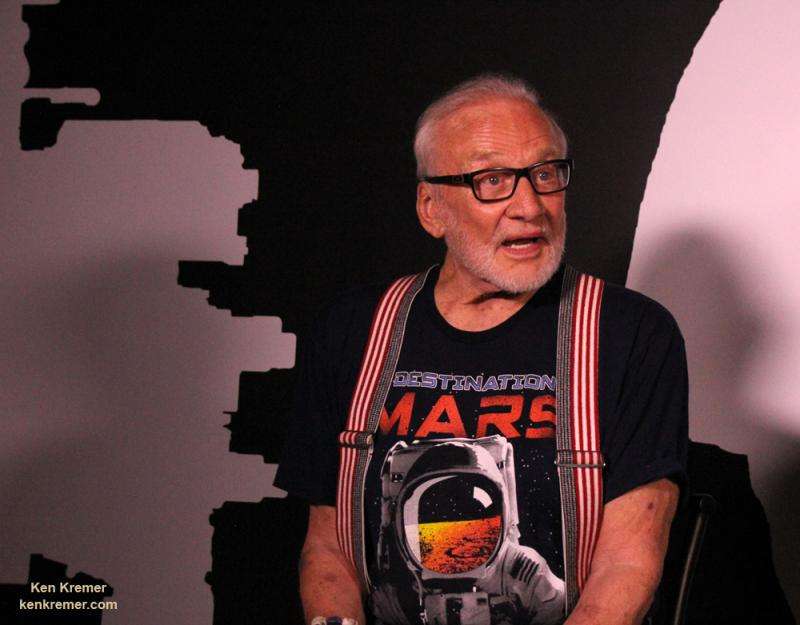Apollo 11 moonwalker Buzz Aldrin discusses the human ‘Journey to Mars with Universe Today at newly opened ‘Destination Mars’ holographic experience during media preview at the Kennedy Space Center visitor complex in Florida on Sept. 18, 2016. Credit: Ken Kremer/kenkremer.com
Sending humans on a 'Journey to Mars' and developing strategies and hardware to accomplish the daunting task of getting 'Humans to Mars' is NASA's agency wide goal and the goal of many space enthusiasts – including Apollo 11 moonwalker Buzz Aldrin.
NASA is going full speed ahead developing the SLS Heavy lift rocket and Orion crew module with a maiden uncrewed launch from the Kennedy Space Center set for late 2018 to the Moon. Crewed Mars missions would follow by the 2030s.
In the marketplace of ideas, there are other competing and corollary proposals as well from government, companies and private citizens on pathways to the Red Planet. For example SpaceX CEO Elon Musk wants to establish a colony on Mars using an Interplanetary Transport System of SpaceX developed rockets and spaceships.
Last week I had the opportunity to ask Apollo 11 Moonwalker Buzz Aldrin for his thoughts about 'Humans to Mars' and the role of commercial space – following the Grand Opening ceremony for the new "Destination Mars' holographic exhibit at the Kennedy Space Center visitor complex in Florida.
Moonwalker Aldrin strongly advocated for more commercial activity in space and that "exposure to microgravity" for "many commercial products" is good, he told Universe Today.
More commercial activities in space would aid space commerce and getting humans to Mars.
"We need to do that," Aldrin told me.
Buzz Aldrin is the second man to set foot on the Moon. He stepped onto the lunar soil a few minutes after Apollo 11 Commander Neil Armstrong, on July 20, 1969 in the Sea of Tranquility.
Aldrin also strongly supports some type of American space station capability "beyond the ISS" to foster the Mars capability.
And we need to be thinking about that follow on "US capability" right now!
"I think we need to have a US capability beyond the ISS to prepare for future activities right from the beginning," Aldrin elaborated.
Currently the ISS partnership of the US, Russia, ESA, Japan and Canada has approved extending the operations of the International Space Station (ISS) until 2024. What comes after that is truly not known.
Credit: Universe Today
NASA is not planning for a follow-on space station in low Earth orbit at this time. The agency seems to prefer development of a commercial space station, perhaps with core modules from Bigelow Aerospace and/or other companies.
So that commercial space station will have to be designed, developed and launched by private companies. NASA and others would then lease space for research and other commercial activities and assorted endeavors on the commercial space station.
For example, Bigelow wants to dock their privately developed B330 habitable module at the ISS by 2020, following launch on a ULA Atlas V. And then spin it off as an independent space station when the ISS program ends – see my story.
Only China has firm plans for a national space station in the 2020's. And the Chinese government has invited other nations to submit proposals. Russia's ever changing space exploration plans may include a space station – but that remains to be actually funded and seen.
Regarding Mars, Aldrin has lectured widely and written books about his concept for "cycling pathways to occupy Mars," he explained.
Source: Universe Today
























